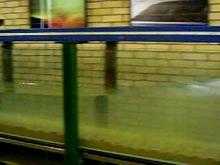Wave flume




In fluid dynamics, a wave flume (or wave channel) is a laboratory facility for the physical modelling of water waves, in order to study their properties and their effects on coastal structures, offshore structures, sediment transport and other transport phenomena.
A wave flume is a special sort of wave tank: the width of the flume is much less than its length. The generated waves are therefore – more or less – two dimensional in a vertical plane (2DV), meaning that the orbital flow velocity component in the direction perpendicular to the flume side wall is much smaller than the other two components of the three dimensional velocity vector. This makes a wave flume a well-suited facility to study near-2DV structures, like cross-sections of a breakwater. Also (3D) constructions providing little blockage to the flow may be tested, e.g. measuring wave forces on vertical cylinders with a diameter much less than the flume width.
The waves are most often generated with a mechanical wavemaker, although there are also wind–wave flumes with (additional) wave generation by an air flow over the water – with the flume closed above by a roof above the free surface. The wavemaker frequently consists of a translating or rotating rigid wave board. Modern wavemakers are computer controlled, and can generate besides periodic waves also random waves, solitary waves, wave groups or even tsunami-like wave motion. The wavemaker is at one end of the wave flume, and at the other end is the construction being tested, or a wave absorber (a beach or special wave absorbing constructions).
Often, the side walls contain glass windows, or are completely made of glass, allowing for a clear visual observation of the experiment, and the easy deployment of optical instruments (e.g. by Laser Doppler velocimetry or particle image velocimetry).
Further reading
Hughes, Steven A. (1993), Physical models and laboratory techniques in coastal engineering, World Scientific, ISBN 978-981-02-1541-5